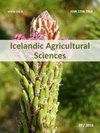maedii -visna病毒是HIV的模型
IF 0.2
4区 农林科学
Q4 AGRICULTURE, MULTIDISCIPLINARY
引用次数: 1
摘要
maedii -visna病毒(MVV)是绵羊的一种慢病毒,可引起许多器官的炎症,主要是肺和中枢神经系统。HIV和SIV也属于逆转录病毒的慢病毒属。MVV和HIV有许多共同特征,包括基因组组织、病毒复制模式、病毒-宿主相互作用和潜伏期。这两种病毒都感染单核细胞/巨噬细胞谱系的细胞,但细胞嗜性的主要区别在于,HIV感染T淋巴细胞,而MVV不感染。本文综述了MVV的分子生物学、细胞趋向性和发病机制,并讨论了MVV与HIV的一些异同。本文章由计算机程序翻译,如有差异,请以英文原文为准。
Maedi-visna virus as a model for HIV
Maedi-visna virus (MVV) is a lentivirus of sheep causing inflammation in many organs, primarily the lungs and CNS. HIV and SIV also belong to the lentivirus genus of retroviruses. MVV and HIV have many features in common, including genome organization, mode of virus replication, virus-host interaction and latency. Both viruses infect cells of the monocyte/macrophage lineage, but the main difference in cell tropism is that, whereas HIV infects T lymphocytes, MVV does not. Here, the molecular biology, cell tropism and pathogenesis of MVV are reviewed and some of the similarities as well as the dissimilarities between MVV and HIV are discussed.
求助全文
通过发布文献求助,成功后即可免费获取论文全文。
去求助
来源期刊

Icelandic Agricultural Sciences
AGRICULTURE, MULTIDISCIPLINARY-
CiteScore
0.80
自引率
0.00%
发文量
0
审稿时长
>12 weeks
期刊介绍:
Icelandic Agricultural Sciences is published annually, or more frequently. The deadline for submitting manuscripts that are intended to appear within that year is September. The journal is in English and is refereed and distributed internationally. It publishes original articles and reviews written by researchers throughout the world on any aspect of applied life sciences that are relevant under boreal, alpine, arctic or subarctic conditions. Relevant subjects include e.g. any kind of environmental research, farming, breeding and diseases of plants and animals, hunting and fisheries, food science, forestry, soil conservation, ecology of managed and natural ecosystems, geothermal ecology, etc.
 求助内容:
求助内容: 应助结果提醒方式:
应助结果提醒方式:


